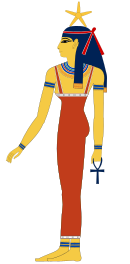Tjenenet
| Tjenenet in hieroglyphics | ||||||||
|---|---|---|---|---|---|---|---|---|
| Tjenenet New Kingdom |
Ṯnnt |
|||||||
| Sopdet-Tjenenet Gr.-Roman. time |
Spdt-ṯnnt |
|||||||
Tjenenet (also Tenenit ) is a nativity and mother goddess in ancient Egyptian mythology , who has been documented as consort of the month in Medamut , Armant and et-Tod since the Middle Kingdom .
background
Representations
| |
From the New Kingdom onwards, Tjenenet is represented in human form with the uterus symbol (Gardiner F45) in the headband, as it guarantees the king's temporal perspective when he is born. At the coronation of Mentuhotep III. in et-death she is equipped with the vulture hood . In addition, Tjenenet appears as a lion with the sun disk or in the shape of a snake with the uraeus symbol of the cobra .
cult
Tjenenet has also been equated with Hathor , Sopdet , Sekhmet , Mut , Wadjet , Nechbet , Junit and Rat-taui . A relief in the Greco-Roman Mammisi by Armant shows her on the side of Junit with the crown of courage. Junit and Rat-taui later take their place in Armant.
With the increasing influence of Amun as a kingdom god, Tjenenet came to Edfu , Esna , Karnak and Dendera ; she also belonged to the Theban gods unity. As the “Chronocrat” she is the deity responsible for the 29th day of the third Schemu month in the Egyptian calendar .
Tjenenet and Month are the two opposite poles of a cyclical event, especially the sunrise and moonrise and also the coronation of the king, which is regarded as a new birth. She is the thirteenth of fourteen deities who fill the lunar eye and represents the fourteenth lunar month day in the Egyptian lunar calendars , which is why she also has an important function as one of the deities participating in the “beautiful festival for Her Majesty's Ipet” .
She plays another special role as the birth deity Sopdet-Tjenenet in connection with the rebirth of Osiris and the New Year celebrations: " In her name Sopdet is exalted in the Duat at Osiris " ( ṯnnt-m-dw3t-ḫr-Wsjr ). In addition, it is mentioned together with the sanctuaries of Chenti-cheti and Sokar .
Tjenenet also carries the titles: "Tjenenet von Armant", "Tjenenet-Junit", "Tjenenet-Junit-Rat-taui", " Tjenenet in Ipet-Sut in Thebes ", "Tjenenet-weret" ( the great Tjenenet ) , "Tjenenet-Hathor", "Tjenenet-Nechbet" and " the beautiful Tjenenet from Armant ".
See also
literature
- Maria-Theresia Derchain-Urtel: Syncretism in Egyptian Iconography. The goddess Tjenenet, part IV. In: Göttinger Orientforschungen. (GOF) IV. Series, Egypt 8, Wiesbaden 1979, p. 88ff.
- Adel Farid: Two New Kingdom Statues from Armant. In: Communications from the German Archaeological Institute, Cairo Department. (MDAIK) Volume 39, 1983, pp. 59-69, especially pp. 62-64.
- Christian Leitz u. a .: Lexicon of the Egyptian gods and names of gods . Volume 7: Š - ḏ. (= Orientalia Lovaniensia analecta. [OLA] Volume 116). Peeters, Leuven 2002, ISBN 90-429-1152-2 .
- Wolfgang Helck , Eberhard Otto , Wolfhart Westendorf (Hrsg.): Lexicon of Egyptology. Volume IV: Megiddo - Pyramids. Harrassowitz, Wiesbaden 1982, ISBN 3-447-02262-0 , column 610.

